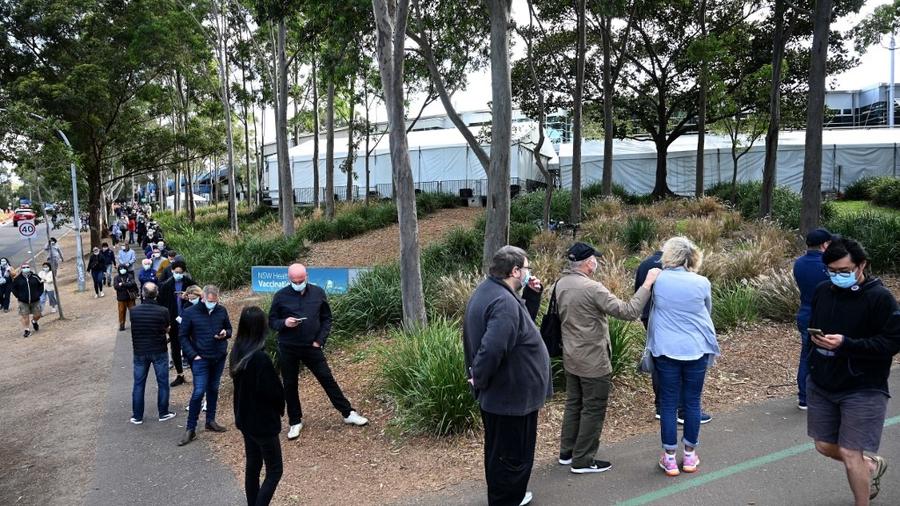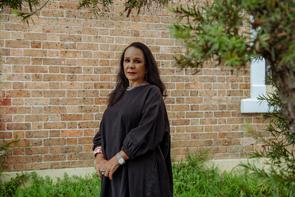 Residents queue up for their doses of the COVID-19 vaccine at the Homebush vaccination center in Sydney on Aug 2, 2021. (PHOTO / AFP)
Residents queue up for their doses of the COVID-19 vaccine at the Homebush vaccination center in Sydney on Aug 2, 2021. (PHOTO / AFP)
Australia’s latest virus outbreak is creating an unprecedented threat to its Indigenous people, with Prime Minister Scott Morrison’s tardy vaccination rollout exposing vulnerable populations as the virus spreads from Sydney to threaten more remote Outback areas.
Authorities at the weekend locked down the entire New South Wales state, which on Monday detected a record 478 new COVID-19 cases as the Delta variant spreads, while Sydney’s stay-at-home orders were toughened seven weeks after being implemented.
On Monday, areas of the Northern Territory including Darwin will enter a snap three-day lockdown after a case was detected; about 30 percent of the territory’s population of about 250,000 people are Indigenous. Meanwhile, authorities in national capital Canberra, which reported 19 new cases on Monday, announced the extension of an initial seven-day lockdown until at least Sept. 2, after Sydney’s Delta outbreak reached the region.
I’m particularly concerned at the moment around Dubbo and the impact COVID-19 is having on Aboriginal communities in Dubbo ... Also that the fact that Aboriginal vaccination levels are not as high as I would like to see them.
Kerry Chant, New South Wales chief health officer
In western New South Wales, hundreds of miles from Sydney, 35 new infections were detected on Monday. The Australian Broadcasting Corp. reported that at least 16 cases at the weekend were found in the city of Dubbo - and all involved Indigenous people.
“I’m particularly concerned at the moment around Dubbo and the impact COVID-19 is having on Aboriginal communities in Dubbo,” Kerry Chant, the state’s chief health officer, told reporters on Monday. “Also that the fact that Aboriginal vaccination levels are not as high as I would like to see them.”
While Indigenous Australians make up about 3 percent of the entire population, that proportion soars in Outback regions that are now being exposed to the virus for the first time since the pandemic began. These rural communities are particularly vulnerable because of higher rates of underlying health conditions such as diabetes and heart disease.
Morrison has been under pressure to ramp up the nation’s vaccination rollout, with less than 20 percent of the population fully inoculated. Just 8 percent of First Nations people in western parts of the state have received both jabs, and 14 percent nationwide, according to Shadow Indigenous Affairs Minister Linda Burney.
“With questions about the capacity of local health facilities to meet any potential outbreak, this is a tragedy waiting to happen,” Burney, the first Indigenous woman elected to the nation’s lower house, said in an emailed statement on Sunday. She called on the federal government to publish daily data on vaccination rates and on the availability of jabs.
ALSO READ: Australia: Entire state of NSW in lockdown virus cases jump
 This undated file photo shows Linda Burney, Australia's Shadow Indigenous Affairs Minister. (PHOTO / BLOOMBERG)
This undated file photo shows Linda Burney, Australia's Shadow Indigenous Affairs Minister. (PHOTO / BLOOMBERG)
While Indigenous Australians make up about 3 percent of the entire population, that proportion soars in Outback regions that are now being exposed to the virus for the first time since the pandemic began. These rural communities are particularly vulnerable because of higher rates of underlying health conditions such as diabetes and heart disease
“The prime minister needs to be held accountable on his promise to make First Nations vaccination a priority,” Burney said. Inoculation rates in some Indigenous communities was as low as 2 percent, she said.
At least 66 Indigenous people have been infected by the virus in New South Wales’ Delta outbreak, about 80 percent of whom are aged under 40, the Guardian reported at the weekend. The state’s health authorities don’t release data breakdowns of cases by ethnicity.
While the federal government’s bid to boost Indigenous vaccination rates has been tested by the logistical problems of safely administering jabs in remote areas with sparse populations, it has enlisted famous First Nations footballer Adam Goodes to promote their use.
The Delta variant is placing increased pressure on Australia’s so-called “COVID Zero” strategy, which has relied on closed international borders and rigorous testing to eliminate community transmission of the virus. That has prompted state governments to put more than half the nation’s population of 26 million people under lockdown, threatening an economic recovery.
While Morrison earlier this year lauded Australia’s ability to control community transmission, contrasting the nation’s often coronavirus-free status with the plight of other nations suffering huge outbreaks, in an interview on Monday he signaled a shift in his conservative government’s messaging.
Inoculation rates in some Indigenous communities was as low as 2 percent, Shadow Indigenous Affairs Minister Linda Burney said
On Saturday, authorities in Sydney said they would tighten restrictions, increase fines and ramp up policing in the nation’s most populous city.
From Monday, there will be a “visible and increased police presence” in areas worst affected by the outbreak, including members of the riot squad, and an extra 500 soldiers to enforce compliance on top of the 300 already on the ground. Fines will be ramped up, including A$5,000 (US$3,685) for quarantine breaches and A$3,000 for exercising outside of guidelines.
READ MORE: Virus: Australia deploys soldiers as PM sets out plan to freedom
Victoria reported another 22 cases on Monday, following 25 on Sunday, making it doubtful that Melbourne will exit stay-at-home orders in the next week. The nation’s second-largest city is in its sixth lockdown since the pandemic began.


